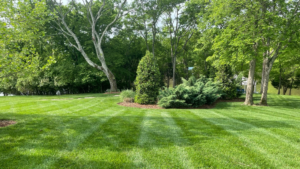If you’ve been staring at your lawn, wondering why it doesn’t look as lush and vibrant as the ones you see in magazines, you’re not alone.
Turf rejuvenation gives your grass the boost it needs to thrive again, without the stress of a complete overhaul.
If your turf is looking worse for wear, rejuvenation is like hitting the reset button. It leaves you with thicker grass, improved durability, and a safer, cleaner space for people to enjoy.
Common Causes of Landscape Decline
Before we jump into possible solutions, let’s break down the main culprits behind declining turf health:
- Compacted Soil: Over time, frequent foot traffic, lawn mowers, or even overly dry conditions can leave soil too tightly packed for grass roots to grow. This compression restricts roots from accessing nutrients, water, and air and causes grass to grow thin and weak.
- High Traffic: Whether it’s frequent playtime in your backyard or heavy foot traffic in a public area, turf suffers when overused. High-traffic spaces often show damage through worn-out paths, flattened grass, and bare areas where natural recovery has been outpaced by use.
- Pests: Pests like grubs, chinch bugs, and lawn caterpillars can wreak havoc by feeding on your grass and its roots. Their damage often results in brown or dying patches of turf that worsen quickly if left unchecked.
- Irrigation Problems: Overwatering or underwatering is one of the sneakiest causes of turf decline you might overlook. Too much water drowns grass roots, while too little prevents growth altogether.
The Impact of Turf Rejuvenation On Your Landscape
A fresh, verdant lawn immediately upgrades the appearance of any outdoor space, making a home feel more inviting or a business feel more polished. High-quality turf is like your property’s first impression—it signals care and creates a positive visual impact for neighbors, guests, or clients.
Healthy turf is also more usable. Kids don’t want to play on dry, crunchy grass, and barbecues aren’t as enjoyable when the grass doesn’t feel nice to walk on.
It’s also important to remember that your lawn isn’t just there to serve as eye candy for passersby. It plays an important role in the environment. Healthy grass naturally improves soil quality, reduces surface runoff, and improves water absorption into the ground.
Core Steps in Turf Rejuvenation
At Puryear Farms, we define turf rejuvenation as taking an existing lawn and transforming it into the thriving, beautiful lawn you’ve always wanted—whether you’re dealing with warm-season or cool-season turf grasses.
Great grass doesn’t happen by chance; it results from specific steps and treatments working together to restore your lawn’s health and beauty. Below, we’ll walk you through those steps:
Core Aeration
Over time, soil can become compacted due to foot traffic, mowing, and natural settling.
Compacted soil makes it harder for your grass to access the elements it needs to thrive, leading to thinning, unhealthy turf. Core aeration breaks through this buildup and breathes life back into the soil.
It involves removing small plugs of soil across your lawn to create tiny holes that allow air, water, and vital nutrients to penetrate deep into the soil. This makes it easier for grass roots to grow strong and deep.
At Puryear Farms, we recommend pairing aeration with overseeding (more on that below) to ensure those newly created holes are planted with the building blocks for a vibrant lawn.
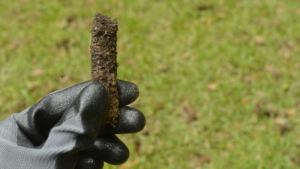
Dethatching
If your lawn’s surface feels spongy or you’ve noticed a layer of dead material sitting between the grass blades and the soil, it’s time for dethatching.
Thatch is the buildup of dead grass, roots, and debris that forms when they don’t decompose quickly enough. While a thin layer of thatch is perfectly normal (and provides some insulation), too much can block water, nutrients, and sunlight from reaching your soil.
Enter dethatching—the process of removing excess thatch to restore balance to your lawn.
Using specialized tools, such as a dethatcher, we comb through your grass to pull out this unnecessary layer. It’s not only satisfying to watch that thick, dead buildup disappear, but it also immediately improves your lawn’s ability to regulate moisture and nutrients.
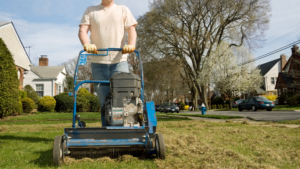
Overseeding
Simply put, overseeding involves spreading new grass seed over your existing lawn to thicken turf and fill in any bare spots. For cool-season grasses, the fall is the perfect time to overseed.
Why overseed? Over time, even the healthiest lawns can thin due to natural factors like use, pests, or weather conditions. Overseeding introduces new, resilient grass varieties into your turf, giving it a fuller, revitalized appearance.
At Puryear Farms, we pair overseeding with core aeration. The small holes created during aeration provide premium conditions for seeds to settle, germinate, and integrate seamlessly into the existing lawn.
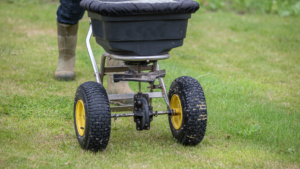
Liquid Herbicide Treatment to Suppress Unwanted Turf Species
We’ve all been there—you focus on growing a pristine lawn, only to have pesky weeds or unwanted turf species steal the show. Liquid herbicide treatments are a targeted way to tackle this issue. The goal? To suppress these invaders so your desired grass species can thrive.
Using a carefully selected herbicide, we treat unwanted grasses while ensuring minimal disruption to the healthy grass in your lawn. We precision-target specific areas rather than applying chemicals haphazardly.
Fertilization
Fertilization is to lawns what good nutrition is to humans. At Puryear Farms, we source our fertilizers locally from Sigma Organics for quality and sustainability.
We’re particularly fond of using organic fertilizers, as they provide long-lasting nutrients while being gentle on the environment. For areas with compacted soil, we also recommend incorporating gypsum to improve soil structure and drainage over time.
A well-fertilized lawn doesn’t just look good; it has the strength to resist pests, disease, and environmental stressors. Applying fertilizer at key times during the year, especially in tandem with other rejuvenation steps, sets your lawn up for long-term success.
Soil Health Assessment (Optional)
A soil health assessment can offer valuable insights for those looking to truly understand their soil’s condition. This process evaluates nutrient levels and pH balance, which can help guide fertilization and other treatments.
Think of it as a wellness check for your lawn—providing you with an accurate and targeted approach to improving its health.
Sustaining Your Landscape
Maintaining healthy turf is not a one-and-done task—it requires a year-round plan. Start by assessing your grass’s specific needs.
Cool-season grasses require different care than warm-season grasses. For example, cool-season grasses should be aerated and seeded in the fall, while warm-season varieties should be fertilized and weeds controlled with pre-emergents in spring.
Some tasks will be seasonal, but others, such as mowing and spot treating weeds, need to happen regularly. Putting the work in year-round minimizes stress on your turf, giving it the foundation to stay green and healthy long-term.
Long-Term Mowing Strategies
Mowing isn’t just about cutting your grass short but about creating conditions for strong, resilient growth. For instance, if you mow your grass too low, you risk exposing the roots to too much sun and heat, which can weaken the turf’s overall health.
The rule of thumb? Never remove more than one-third of the grass height in a single mow.
Keeping your blades sharp is equally important—a dull blade will rip the grass instead of cutting it cleanly, making your turf look ragged and stressed.
Adjust your mowing patterns, too. Alternating the direction of your mow reduces compaction and promotes even growth.
During peak growing seasons, such as the spring and summer, you may need to mow more often.
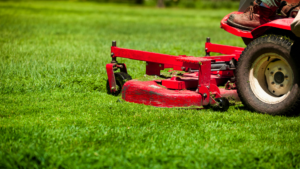
Fertilization for Long-Term Success
With the right fertilization routine, you can help your turf outcompete weeds, thrive during peak growing seasons, and recover after harsh conditions.
At Puryear Farms, we recommend using organic fertilizers whenever possible—these are not only better for your plants but also for the environment. To keep things simple, think of fertilization in phases:
- Spring/Early Summer: Use nitrogen-rich fertilizers to promote vibrant green growth.
- Late Summer/Fall: Use fertilizers with lower nitrogen levels and higher potassium to strengthen the turf for the colder months.
Consider a recurring turf health program to stay ahead of issues like weeds. Pre-emergent applications at the right time of year can prevent unwanted weeds from germinating and taking over your yard.
How to Keep Your Irrigation Going Strong
No turf can thrive without water, but managing irrigation is about more than just turning the sprinklers on. It’s about making sure every inch of your turf gets the right amount of water without waste.
One helpful practice is conducting regular irrigation checks, especially before the warmer months roll in. Test your system to confirm that it delivers uniform coverage and fix any broken or inefficient sprinkler heads. At Puryear Farms, we also flag irrigation heads during aeration. This helps us avoid accidental damage to your irrigation system while we’re conducting soil aeration or other important tasks.
Long-Term Monitoring for Lasting Results
Keeping turf healthy isn’t a set-it-and-forget-it kind of deal. Long-term monitoring is key to identifying and addressing issues before they become major problems.
Check for signs of stress, such as discoloration, thinning grass, or excessive weed growth. These signs can indicate issues like nutrient deficiencies, pest infestations, or irrigation problems.
At Puryear Farms, we believe in working proactively. A scheduled monitoring plan that includes soil testing, turf health assessments, and regular maintenance ensures your turf doesn’t just survive—it thrives.
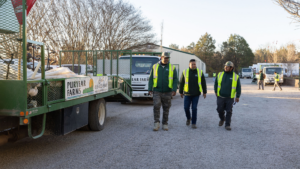
Why Work with Professionals
The temptation to tackle turf rejuvenation on your own can be strong. After all, how hard can it be, right? But while a DIY approach might save a few bucks upfront, it often leads to headaches down the road.
From improper soil treatments to over-fertilizing, mistakes can mean uneven growth or even a lawn in worse shape than before. Sometimes, it’s just better to leave it to the professionals. Here’s why:
Expertise in Large-Scale Rejuvenation Projects
We’ve seen it all—patchy lawns, overgrown weeds, compacted soil—and we know exactly how to tackle those issues head-on. Whether it’s a residential yard or a sprawling commercial space, we can assess the condition of your turf and design a step-by-step plan to bring it back to life.
We don’t just treat what’s on the surface. We focus on the root (literally) of the problem. This often involves analyzing soil health, understanding drainage patterns, and identifying pest or disease issues that might be holding your grass back. Instead of guessing what might work, we provide targeted solutions backed by years of expertise.
Access to Advanced Equipment and Tailored Solutions
Aerators, dethatchers, and precision sprayers are just a few of the tools we use to give your turf exactly what it needs. High-quality equipment significantly improves the effectiveness of treatments, guaranteeing even coverage and reducing the risk of mistakes.
But it’s not just about fancy tools. We also have access to premium seeds, fertilizers, and soil treatments that aren’t available at your local garden store. These products can rejuvenate your lawn faster and more effectively than anything you’d find on your own.
Every lawn is unique, with its own challenges and needs. Our team of professionals will take the time to evaluate factors like soil composition, climate, and desired outcomes to craft a plan that works specifically for your property.
Optimal Results for Commercial Properties, HOAs, or Municipal Spaces
For business owners, HOA managers, or municipal officials, first impressions matter. A healthy, green lawn doesn’t just look good—it communicates care and attention to detail. Whether it’s a welcoming entrance to a business or a well-maintained park for a community, attractive turf can significantly boost a space’s aesthetic appeal.
Professionals like those on our team understand the high standards required for these properties. From keeping lawns weed-free to ensuring uniform growth across larger spaces, we know how to deliver results that stand out. And with regular maintenance programs available, we can help organizations keep their turf looking its best year-round.
If you’re managing a large property, outsourcing lawn care to professionals like our team at Puryear Farms can also save you valuable time and effort. Instead of having to oversee every treatment or worry about whether the right products are being used, you can step back and trust that your turf is in our capable hands.
Final Thoughts
A rejuvenated lawn doesn’t happen overnight. Be prepared for an initial investment in multiple treatments to set the groundwork for long-term success. Depending on your lawn’s condition and your goals, it typically takes around two to three years to achieve full results.
The good news? Investing in ongoing maintenance programs can simplify this process. That way, the progress you make today doesn’t get undone tomorrow.
Turf rejuvenation is more than just grass—it’s about creating vibrant, resilient spaces that enhance your property and make it enjoyable for years to come. At Puryear Farms, we specialize in taking your lawn to the next level so you can do just that.
Schedule a consultation with our team today to learn more about our turf rejuvenation services. Whether you’re an HOA manager looking for long-term maintenance solutions or a homeowner ready to transform your front yard, we’re here to help.
Together, we’ll create a sustainable, healthy lawn you can be proud of.

